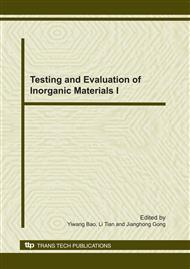p.485
p.489
p.493
p.497
p.502
p.506
p.510
p.514
p.518
Modification of CaO Refractory for Melting Titanium Alloys and its Hydration Resistance
Abstract:
CaO is a promising refractory for melting TiNi shape memory alloys, the carbon contamination can be avoid by using CaO crucible instead of carbon crucible. However, its industrial application is limited by the easy hydration of CaO in the air. In this study, the hydration resistance of CaO is modified by the addition of ZrO2, the powder of CaO adding 6.0 to 15.0mol% ZrO2 and 2.0mol% TiO2 is ball- milled, the mixture is shaped into the chip by the isostatic pressing method (IP), then the samples are sintered at 1750°C. The X-ray diffraction analysis reveals that the sintered samples consist of CaO dissolved with ZrO2 and CaZrO3. The anti-hydration property is described by the weight addition of samples, which are stored at the room temperature and atmosphere. It is shown that the sample with 12% ZrO2 of additive possesses the good hydration resistance, its weight addition stored after 56-days is less than 0.6wt%. Therefore, the powder of CaO with 12.0% ZrO2 additive are used to prepare the crucible by IP, the green crucible is sintered at 1750°C. This home-made crucible is used for melting TiNi alloy by means of the induction method at 1500~1800°C temperature and the vacuum environment, it is found that, the internal and external surface of crucible were almost kept unchanged after melting, this refractory did not obviously react with titanium melts, this result may provide a support for searching a new refractory with the good hydration resistance for melting of titanium alloys.
Info:
Periodical:
Pages:
502-505
Citation:
Online since:
December 2010
Authors:
Keywords:
Price:
Сopyright:
© 2011 Trans Tech Publications Ltd. All Rights Reserved
Share:
Citation:


